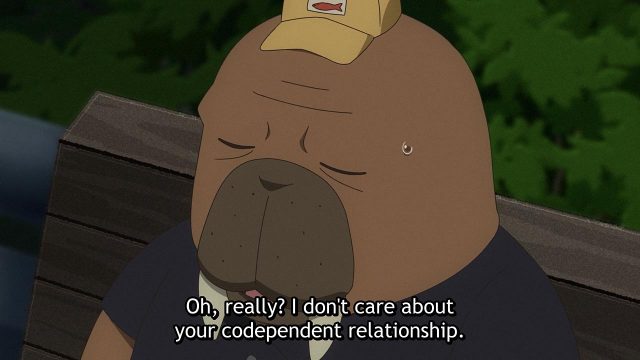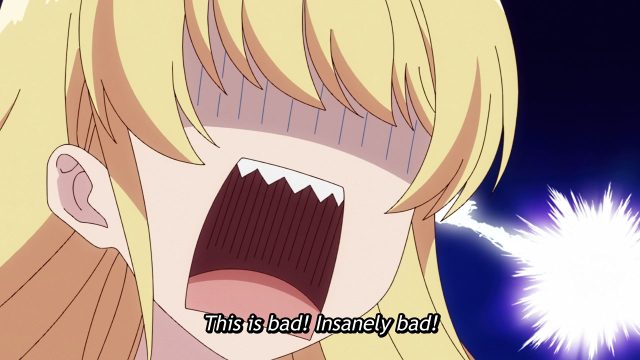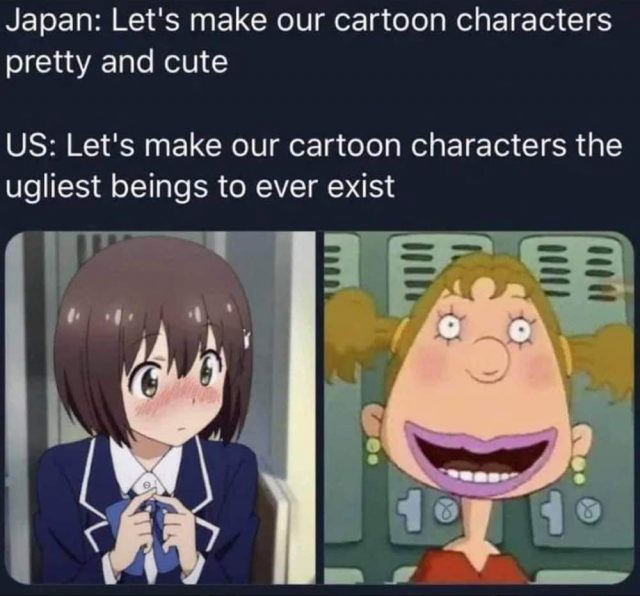I’m down to two shows, which is still twice as many as I was following at this time last year. The best remains Miss Kuroitsu from the Monster Development Department. However, despite its squicky premise, Life with an Ordinary Guy… hasn’t made me throw up yet. It helps to know your isekai clichés.
Category: Animation
Mushroom terrorism
Coming soon
The voice-over in one episode preview in Galaxy Angel AA from twenty years ago has nothing to do with the episode it is presumably describing, yet it seems strangely prescient.
Catching up: anime
Exaggerated and unfair, but true.
***

I finished OddTaxi. Noir with (mostly) cute animals works pretty well when the writing is strong. It likely is the best show of the year, though I can’t say for sure because I haven’t watched more than a few episodes of anything else. Considered as anime, it’s something out of the ordinary and worth sampling if you have an interest in animated storytelling. Considered as noir, I’m not so sure. My knowledge of the genre doesn’t extend far beyond “Watching the Detectives,” and I suspect that connoisseurs might find the ending unsatisfyingly upbeat. Iniksbane has mixed feelings. Nick Creamer discusses the first episode in detail here.
And that’s it for 2021. Nothing this fall looks interesting, so I’ll pop in a disc of Hozuki or Humanity Has Declined when I’m in the mood to watch something.
When girls had noses
The oldest item in Richard’s box of Japanese magazines is a copy of MyAnime. Here are some scans illustrating the state of anime thirty-six years ago. These are large scans; right-click and open in a new window to see them at full resolution.
Thirty-one years ago
Here’s another magazine from Richard’s box, this time from 1990.
Heavy and cute

So, is Odd Taxi really noir? Let’s check with Roger Ebert.
Film noir is . . .
1. A French term meaning “black film,” or film of the night, inspired by the Series Noir, a line of cheap paperbacks that translated hard-boiled American crime authors and found a popular audience in France.
Nearly every scene in Odd Taxi takes place during the evening or night. Check.
Thirty years ago
I recently unearthed Richard’s box of Japanese magazines and scanned a few more. This batch is from the February 1991 Newtype. It provides a snapshot of what anime was during the age of the laser disc. (The magazine pages are a little larger than my scanner can handle and there are missing edges.) These are big scans, so right-click and open in a new window to see every detail.
Snapshots of wasted time
Geology and furry noir
The second season of Yuru Camp concluded with a four-episode trip around the Izu peninsula south of Tokyo. It was mostly more of the same — girls go camping in cool weather, and nothing much happens. Which is fine; spending time with the introverted, independent Rin is enough. (The next hard drive I buy will be named “Rin,” joining the company of Kino, Marika and Isako.)
Among its other virtues, the show was almost entirely free of common fanservice — the beach episode lasted maybe ten seconds and occurred only in one character’s imagination. However, there was plenty of scenery and food porn. One unexpected pleasure was the show’s awareness of the geological history of Izu. Although Japan has numerous volcanoes, some very active, they rarely figure in anime.

If you’d like to see the real-world counterparts of the locations in Yuru Camp, infinitezenith has you covered: one, two, three, four, five, six.
Here’s one reason for Yuru Camp‘s success:
Business Insider interviewed Laid-Back Camp producer Shōichi Hotta, where he shared some of the secrets behind the hit anime. He said that although the manga is published in Manga Time Kirara, which tends to be associated with slice-of-life stories that emphasize cute girls, Laid-Back Camp has some slightly different nuances to its appeal, and he wanted to ensure that this was captured by the anime. Specifically, there were two things that he set out to avoid:
1. When a character praises another one of the other girls, don’t make them say “You’re cute.”
2. Don’t let them get touchy-feely so easily.He explained that doing so would pigeon-hole the genre, and also that these kinds of depictions weren’t in the original manga to begin with.
*****
I’ve been checking out first episodes of the current season on Crunchyroll as they become available to non-subscribers. As usual, I rarely can tolerate more than five minutes of most, but I did watch the debut of OddTaxi twice. It looks like a kid’s show — simple art, anthropomorphized animal characters — but it has a satirical edge and looks like it could get quite dark. The central character, a walrus who drives a taxi, is blunt and cynical. There are strong hints of police corruption and various nefarious goings-on, and probably everyone has a secret. Despite appearances, it’s not for children. What the central story will be isn’t clear yet, but I will probably continue to watch this.
Bingo with Hozuki
I won my first wristwatch playing bingo with my grandmother in Atlantic City a thousand years ago. Back then, the grid just had numbers. Nowadays, you can make anime bingo cards, such as the one I assembled, above. I tried to include a wide range of shows, some well-known, some obscure. All are worth watching, though some aren’t for everyone.
(Via Otaku Lounge.)
Additional views of Mt. Fuji
Crunchyroll has discontinued the obnoxious politicized ads that repelled me last spring, and merely dumb ads I can endure, so I am able to watch the occasional show now. The second season of laid-back Yuru Camp through the first six episodes is much like the first. Girls with hair in unnatural colors go camping, and that’s about it. The installments focusing on solitary, self-reliant Rin are a pleasure to watch. Nadeshiko is also pleasant to spend time with, but the other girls in the camping club quickly become annoying.
A moment from the third episode:
Is “loneliness” an accurate translation? “Solitude” or “isolation” would fit the context better, at least to me.
The distortions of extreme wide-angle lenses are sometimes tolerable in photographs but look weird in drawings.
And now for something vaguely nostalgic

TWWK recently posted his “top 30” anime series. Although I’ve quit following current shows, I still frequently rewatch old favorites, and I thought it might be fun to assemble my own list. TWWK doesn’t define what he means by “top,” and neither shall I.
1. Haibane Renmei
2. Serial Experiments Lain
3. Dennou Coil
4. Shingu
5. Mononoke
6. Oh! Edo Rocket
7. Humanity Has Declined
8. From the New World
9. Hozuki no Reitetsu
10. Cardcaptor Sakura
11. Mouretsu Pirates
12. Natsume Yuujincho
13. Shounen Onmyouji
14. Animal Yokocho
15. Kino’s Journey (2003)
16. Gurren-Lagann
17. Madoka Magica
18. Princess Tutu
19. Mushishi
20. Crest/Banner of the Stars
21. Kill la Kill
22. Dirty Pair (OVA)
23. Katanagatari
24. Galaxy Angel (including Z and A)
25. Jubei-Chan: The Secret of the Lovely Eye Patch
26. Un-Go
27. Joshiraku
28. Pupipo
29. Noir
30. Ouran High School Host Club
Honorable mentions: Cromartie High school, Tsuritama, Kaiba, Magical Witch Punie-chan, Kerero Gunsou, [C] Control.
The morbidly curious can find information on these shows along with plentiful spoilers at TV Tropes. Many of them can be viewed at Crunchyroll or Tubi.
Tenderized
Princess Mononoke wasn’t quite what Disney expected:
Disney executives like Michael O. Johnson, the president of Walt Disney International, had only seen Castle in the Sky, My Neighbour Totoro and Kiki’s Delivery Service, and were expecting similar child-friendly films when they took on Ghibli’s world distribution. Johnson was hence entertainingly horrified when he visited the Tokyo office and saw clips of the film in production, including a graphic moment of decapitation, and the heroine wiping blood around her mouth. Johnson begged Suzuki to change it, pleading that his own head would roll unless he could deliver something more sedate: “Do we have to have the arms and heads flying off? Isn’t there something softer in the film? Romance maybe? Can’t I get a nice romantic scene, you know, between the hero and heroine? Maybe a kiss or something?” The final cut of the trailer included a shot of the wolf-girl San feeding Prince Ashitaka a piece of meat, mouth-to-mouth. Johnson went away delighted, and nobody corrected him when he thought he’d just witnessed a tender kiss.
In the midst of all of this, surrounded by toadies and flunkies, duelling cockswans and shouty executives, Hayao Miyazaki sends back his drink at a restaurant, telling the waiter that it is not the forty-year-old port that he ordered. The waiter insists that it is, but Miyazaki sticks to his guns, until a sheepish manager admits that they had, indeed, tried to fob him off with a cheaper variety. He remains the only one who is true of heart, in a Sea of Corruption.
Just wondering
Are the members of Gryphon closet Sailor Moon fans?
Before anime
My Crunchyroll subscription lapsed a month ago. I’m pretty much done with anime, though I’ll probably always retain some interest. Possibly someone might like to read about my experiences and thoughts, so I’ll write a few summary posts, starting with some pre-history.
I quit watching television when I realized that I could accurately predict the events of an action/adventure/spy show from the first five minutes. This was ‘way back in prehistoric times, when there were only three channels.1 The rest of the family remained addicts, and there was usually a television on in the house at all waking hours and halfway through the night.2 I typically spent my evenings alone in my room, reading, while my parents sat in front of the television.
Movies were a novelty in the small city where I spent the largest portion of my childhood. There was one theater, with just one screen, and one drive-in. You had little choice in what to watch. Consequently, I saw few movies when I was young, and those were mostly thrillers at the drive-in, when my parents tossed me in the back of the car expecting me to sleep while they watched. I had insomnia even then, but I usually found the films more annoying than interesting. (I had nightmares about crop-dusting airplanes after they saw North by Northwest.) Later on in other places we lived, there were multiple theaters available, often with several screens. Unfortunately, movie-going was a family activity, and by then I had had enough of family. With a few exceptions (the Marx Brothers, Ealing Studios comedies, Ray Harryhausen), I never learned to like movies much.
There were a couple of items that presaged my interest in Japanese animation.
First were Saturday morning cartoons. Back in ancient times when I still watched television, my friends and I woke up at dawn on Saturdays and turned the television on, even though at that hour stations just broadcast test patterns, so that we would not miss anything once the programs started. Eventually our parents would wake up and throw us out of the house, but not before we had watched several hours of animation.
Cartoons fell into three classes. The least interesting were the innumerable Hanna-Barbera productions and similar. Yogi Bear, Quick-Draw McGraw, Top Cat, etc., they were all just mere entertainment: formulaic, cheap-looking and bland. They were better than a test pattern, but not by much.
Vastly better were the old Warner Brothers cartoons. These were superior in every respect to HB productions: voice acting, character design, art, animation, music, and particularly the writing. Bugs Bunny was far more vivid and alive than Yogi Bear could ever be. Bugs made me a Raymond Scott fan, too, though I didn’t know that at the time.
The best were the Jay Ward productions. Rocky and Bullwinkle looked even cheaper than Yogi Bear, but it didn’t matter. When the scripts were good, they were brilliant, and they were good more often than not.3 George of the Jungle was consistently good; Hoppity Hooper was downright trippy, as I recall (it’s hard to find; the episodes I’ve unearthed are decidedly eccentric, but I need to see more.) Although the shows were presented as kids’ entertainment, they were written for adults rather than dumbed down for dull children. Bullwinkle is one of the three great comic characters of the 20th century, along with Groucho Marx and Ignatius Reilly.
The other harbinger was Shounen Sarutobi Sasuke. This was the first animated Japanese movie to get a proper release in America, under the title Magic Boy. It turned up one Saturday afternoon at the kids’ matinee, and it blew away all the Disney movies I had ever seen. I thought it was the greatest movie ever made. I later saw Forbidden Planet, and that was the greatest movie ever made, and I eventually forgot Magic Boy.
Some years back, I tracked down a fansub of the movie. By every objective criterion it’s inferior to Disney products. But it had wildness and strangeness absent from its carefully-polished occidental counterparts, and it excited my imagination as no Disney movie ever had.
Books and music took the place of movies and television for me.
Half a lifetime later, I read a news article about a new children’s show being imported from Japan. It had something to do with girls who identified with the planets of the solar system and wore sailor suits. It sounded silly, but I was curious.
Several years after that, I read a review of an animated movie called Perfect Blue. It seemed worth seeing. Too bad it would never come to Wichita. Princess Mononoke looked interesting, too, but it also was unlikely ever to be shown here.
Not quite 20 years ago, a bodhran-playing friend turned out to have a DVD of Princess Mononoke. I asked to borrow it.
Update: I was annoyed to find that recent reissues of Rocky and Bullwinkle on DVD substituted different music for most of the openings and endings. Fortunately, you can find the correct music here. Pianists looking to enlarge their repertoire might consider assembling the incidental music to Dudley Do-Right into “silent movie” suite.
***
Don’t hold your breath waiting for the next installment.




















